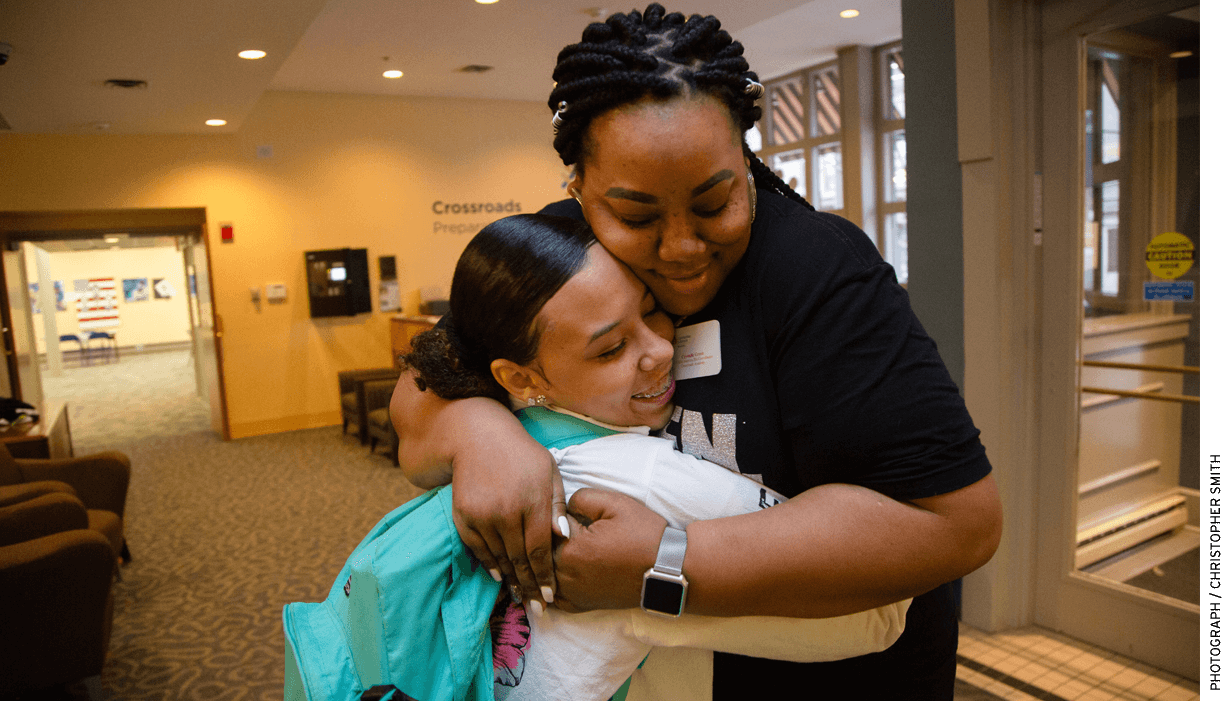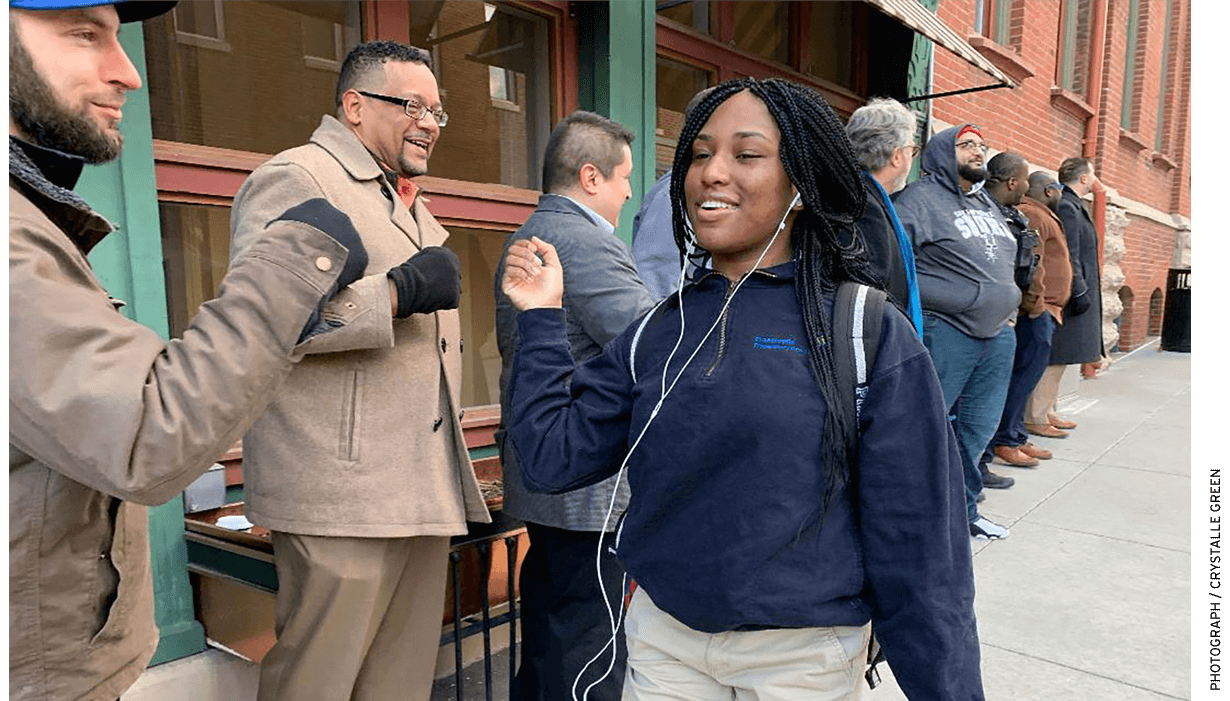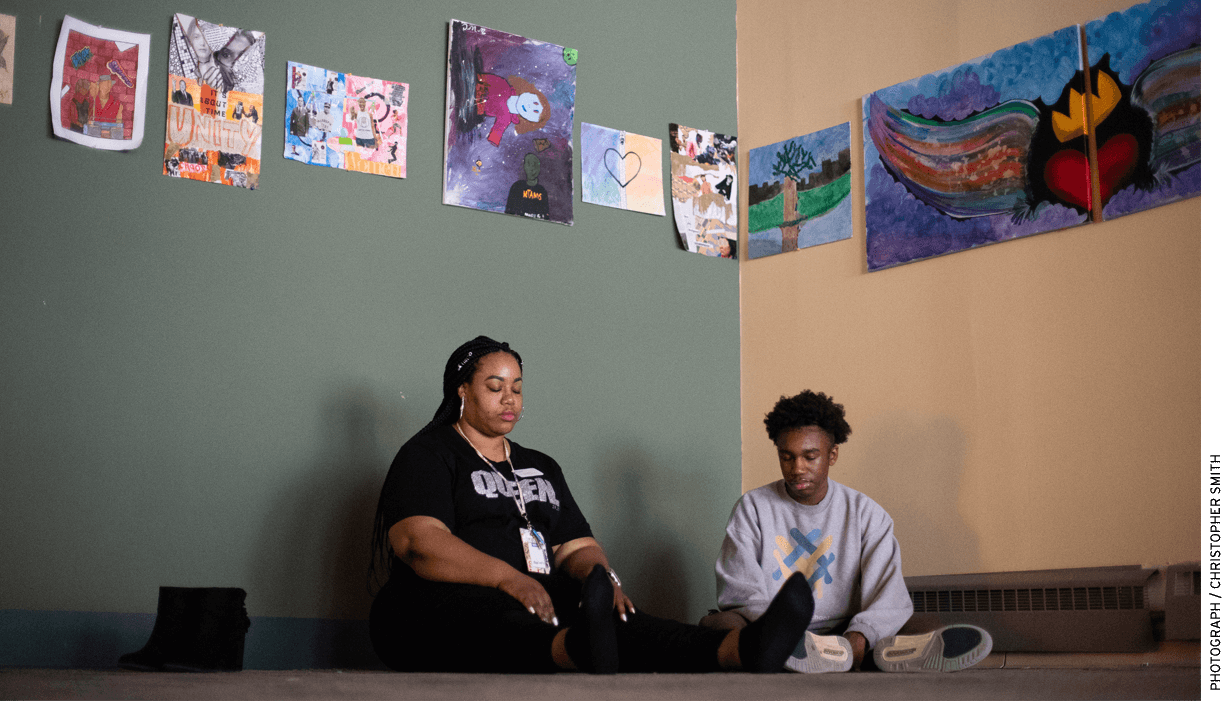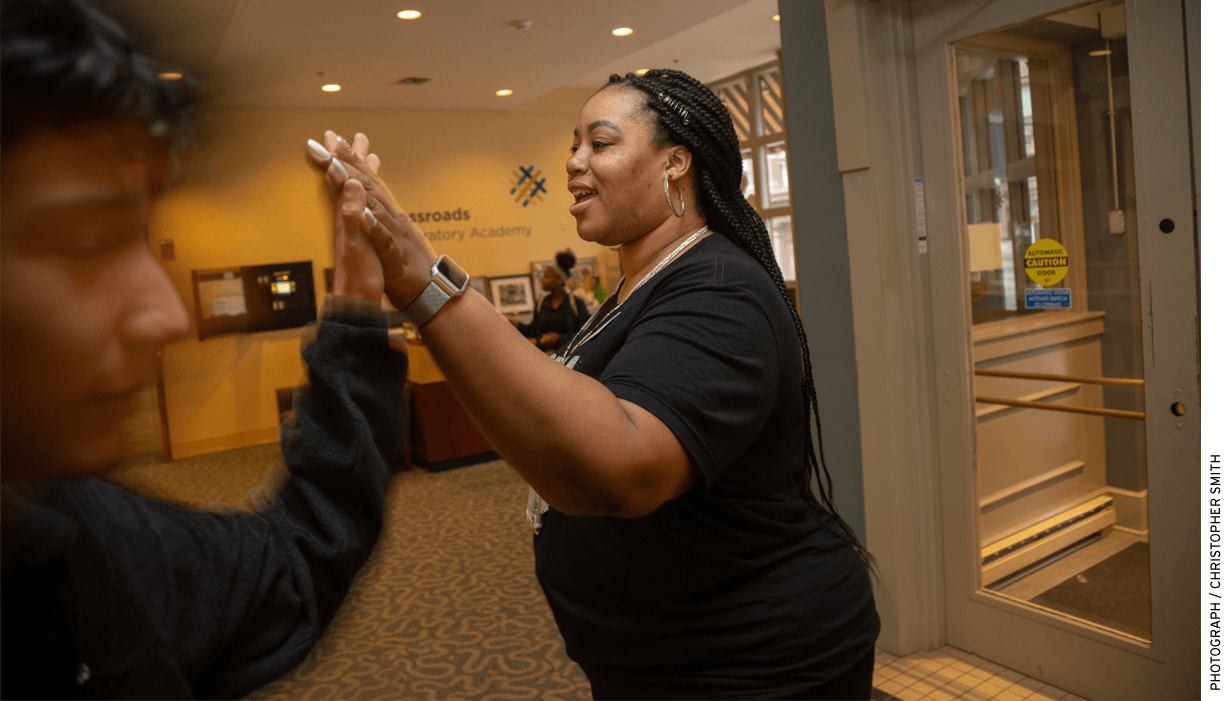
It’s 7:30 a.m. on a cold morning in downtown Kansas City, Missouri. The sun is barely over the horizon and students haven’t yet arrived at the Crossroads Preparatory Academy charter school, but Crystalle Green is already setting up coffee, orange juice, and an array of LaMar’s doughnuts, a local favorite.
It’s all part of the job for Green, a former teacher turned site coordinator for Communities in Schools, a nationwide nonprofit “integrated student support” organization. Crossroads, which operates three charter schools in Kansas City, partners with Communities in Schools of Mid-America to provide social services to its students, either directly or by connecting them with existing programs in the local community. Green works onsite in a wide-ranging role, from giving out toiletries to counseling students with behavioral challenges. Today, that partnership takes the form of “Motivation Monday,” in which the Crossroads teenage students will be greeted by a group of young professional men from the community recruited to mingle and inspire at the start of the day.
After the students, who are in grades 7 through 11, have passed the gauntlet of fist bumps, high-fives, and snacks, they walk past Green. She greets them:
“I love your coat!”
“I need to see you before the end of the day!”
“Oh, so just because you got a new haircut you think that you don’t need to say good morning to me?”
Many come up and hug her.
Green does not stop moving during an hours-long visit. After she makes sure someone takes a picture of the Motivational Monday festivities, she pokes her head into a dedicated “restorative space” the school has set aside for students with behavior issues to see if anyone on her caseload is in there. Then her cell phone buzzes with a text: a student is having a rough morning, so she makes a note to let the girl’s teacher know they’ll be meeting for the first few minutes of second period. She even pops into the last few minutes of a music class to join students in singing the final chorus of Leonard Cohen’s “Hallelujah.” And that’s all in addition to meeting individually with the six students on that day’s counseling schedule.
This is the nitty-gritty of integrated student supports, which aim to address barriers to learning from students’ lives outside of school, such as homelessness, mental health issues, or food insecurity. In such programs, an onsite coordinator like Green serves as hallway cheerleader, listening ear, and point of connection to social services and other community resources, in addition to implementing schoolwide programming targeted at boosting attendance, persistence, and academic success.
While these interventions are not new, their profile is on the rise since the 2015 passage of the Every Student Succeeds Act (ESSA), which for the first time specifically encouraged districts to provide integrated student supports and allowed more federal dollars to pay for them. But a close look at the research on their effectiveness reveals an open question: while integrated supports may help meet students’ physical and emotional needs, their ability to improve student learning remains unproven.

A Holistic Approach
Communities in Schools is one of the nation’s oldest and largest providers of integrated student supports, also known as “wraparound services.” Started in New York City in the 1970s, the agency now works with more than 2,300 schools in 25 states and the District of Columbia. Its board of directors is led by casino magnate Elaine Wynn and includes former federal education secretary Arne Duncan.
The model is straightforward: Communities in Schools recruits, trains, and places “site coordinators” in schools (typically high-poverty campuses where student performance is low), who usually work full time at the school and connect students to community resources available to them. This could include medical and dental care, mental health services, basic needs like food or shelter, academic enrichment programs, tutoring, and mentoring. Its services typically cost around $200 per student per school year.
Communities in Schools also relies on site coordinators like Green as a way to connect local schools with the overall organization, which functions as a federation of 131 “affiliate” nonprofits implementing the model. The national organization will occasionally bring in supports or programs that don’t already exist in needy communities, and also works to evaluate interventions and inform local partners about better practices. Its revenue comes from a combination of sources: about 60 percent comes from public dollars, such as district budgets and federal funding from the Education and Health and Human Services departments, and about 40 percent comes from fundraising, including from supporters like the Wallace Foundation and corporate gifts such as a $30 million grant by pharmaceutical firm AbbVie.
At Crossroads, Green works with 65 students, meeting with each at least once a month; setting goals with that student for either behavioral, academic, or attendance improvement; and tracking his or her progress toward those goals. She also does small-group sessions with multiple students in her caseload who might have similar needs.
Her efforts target student needs throughout the school: she has a spreadsheet of local community-service providers and connects students to mental health counseling, food banks, crisis intervention, or a host of other supports. Onsite, she maintains a stash of hygiene products, school supplies, shoes, and extra uniform pants. And because the school has set improving student behavior as its overall goal, Green has implemented a schoolwide rewards system that includes letting students earn a respite from their uniforms on “dress down” days; a lunch buddies program to encourage students to socialize; “just because” days, when students get rewards “just because”; and social events like dances to help students connect with their school in positive ways.
Similar types of programs are being implemented across the country. A major expansion of wraparound services is underway in New York City, the nation’s largest school district, where Mayor Bill de Blasio has established 239 “community schools” to offer health and social services that will cost $198.6 million and serve more than 100,000 students this school year. Philanthropies have supported similar efforts on a smaller scale, including grants by the Bill & Melinda Gates Foundation and the Chan Zuckerberg Initiative, which last year gave $150,000 to 10 coordinators of wraparound services across the country as part of its Together for Students initiative. The Ballmer Group, founded by former Microsoft CEO Steve Ballmer, has given broadly to such initiatives, including $15 million to Communities in Schools to target dropout-prevention efforts.
The growth is no surprise to Heather Clawson, executive vice president for research, learning, and accreditation of Communities in Schools.
“Student supports have been a ‘nice to have,’” she says. However, “it is no longer a nice to have. It is an essential part of educating our children for the future.”
Disappointing Research
The impact of integrated student supports is often obvious when it comes to meeting students’ immediate needs for food or medical care. But the larger-scale goal of such programs is to improve students’ long-term academic and personal success, and in those terms, their effectiveness is less clear. Large-scale evaluations of wraparound programs to date have shown only small benefits to student achievement, at best.
Surveys of research findings by Child Trends in 2014 and 2017 reported “a growing evidence base” for such interventions and noted researchers’ optimism about their effectiveness; however, researchers concluded that “the evidence is not yet complete” and noted the need for more detailed study. The updated 2017 report also looked in-depth at eight programs, including Communities in Schools and City Connects, and noted the importance of high-quality implementation and lack of measures for non-academic goals like improved grit and social skills. In addition, because integrated student-support programs comprise five distinct elements—needs assessment, community partnerships, coordinated student support, integration within school, and data tracking—determining the nature of high-quality implementation is complex. Such study, the researchers noted, is “the critical frontier for research and practice.”
Communities in Schools has invested in multiple third-party evaluations of its programs. The most recent, published by MDRC in 2017, evaluated both of its models: Tier 1 “whole school” intervention and Tier 2 “case management” services for specific high-risk students. The quasi-experimental study of the whole-school model compared 53 schools in Texas and North Carolina with similar schools not implementing the model and found some modest effects: elementary-school attendance rates improved more than in comparable schools, for example. However, although high-school graduation rates increased, they did not improve more than at the comparison schools. The researchers found no impact on middle-school attendance, and were unable to calculate the program’s impact on behavior due to data limitations.
The other evaluation was a random-assignment study of the Tier 2 case-management intervention in 24 mostly urban, low-income secondary schools in two unnamed states. It found that students who had a Communities in Schools case manager used support services more and showed improved attitudes about school and better relationships with adults and peers. Researchers did not, however, find evidence of improved student achievement, attendance, or behavior.
This lines up with most of the research on integrated student-support programs. “There are a lot of null findings,” says Kristin Anderson Moore, a senior scholar and past president at Child Trends who co-authored the “Making the Grade” reports. Results are “neutral to positive when the methods are strong” and there are “almost no negative effects,” but many advocates are still disappointed with findings that are far from a slam dunk. That vexes practitioners, advocates, and researchers alike because, as Anderson Moore puts it, such programs are “aligned with everything we know about child development.”
In addition, researchers and practitioners have made “critical correlations” between key elements of integrated student supports, such as student engagement and student learning, for example, and between self-regulation and academic success, says Brooke Stafford-Brizard, a director at the Chan Zuckerberg Initiative. And yet when everything comes together, the result underwhelms.
Some impacts simply must be true. If a student has poor eyesight and cannot see her teacher or the words on the page of her book, eyeglasses will improve her ability to learn. Others are quite plausible. For example, it is likely that students who feel that they have trusted adults in their lives, people who will support them in their times of need, will learn better. And yet the findings of large-scale evaluations have not shown significant improvements to student achievement as a result of these programs. There is still a huge gap in understanding which interventions affect which outcomes and how those outcomes are related to each other.
There is at least one exception: City Connects, which began in Boston in 1999 and now serves students in more than 100 schools in six states. In 2018, a Boston College study found that students enrolled at City Connects elementary schools had about half the odds of dropping out of high school as teenagers. Researchers tracked 894 students who entered kindergarten between 2000 and 2004 at City Connects schools, where local site coordinators monitor every student’s progress and challenges, in conjunction with their teachers, every year. Based on those data, students are individually connected to community services and enrichment opportunities to boost their academics, mental and physical health, social development, and family well-being.
One likely source of the model’s impact on dropouts is its early start, according to Mary E. Walsh, a study co-author and executive director of City Connects.
“A comprehensive intervention in elementary school that addresses a wide range of out-of-school factors can disrupt those pathways, supporting strengths and building resilience,” she wrote in a summary published by the American Educational Research Association.

Plumbing the Evidence Base
Still, the overall research base is far from conclusive. There are several potential explanations for the persistent lack of demonstrable success.
First, neither the research community nor practitioners know the right “mix” of services to provide to students. As Anderson Moore puts it: “Is what’s really important stable housing or health insurance? What makes it click?”
Some interventions are more expensive than others. Some are more intense. While many have been studied in isolation, how do they work together? In addition, students have multiple needs that might prevent them from being successful in the classroom. Is meeting just some of those needs enough? Which needs are the highest priority? These are the questions that remain unanswered. It could be that integrated student-support providers are not prioritizing the right interventions, or that they are undercutting their success by promoting multiple interventions at once.
Second, there are local capacity issues. Large organizations like Communities in Schools have the resources to gather and analyze data, and organizations with outside support, such as those subsidized by the Chan Zuckerberg Initiative, are trying to build capacity around data analytics and coordination. But many communities lack these partners.
Coordinating dozens of service providers helping hundreds of students is challenging. Trying to coordinate these services while evaluating their performance and adjusting behavior based on that information is even harder. Can local site coordinators do this type of analysis and evaluation? How do they know that the partners they choose are the best potential assets in the community? Local coordinators may not have the time or resources to do the type of research needed to weigh one intervention against another. They have to do their best to find partners and then make judgments, often based on limited information, about how well those partners are performing.
This presents a vulnerability. If site coordinators are overwhelmed by the vast array of potential social-service organizations or lack useful data or the ability to analyze which providers might be more effective than others, they can struggle to identify good groups in the community with whom to partner.
Ohio’s Strive Partnership is trying to solve that problem. Described by executive director Byron White as “a backbone organization,” Strive provides data analytics, capacity building, and community strategy support for the web of organizations that provide services for school-age children in Cincinnati and northern Kentucky and the schools and districts looking to partner with them. “To the student,” he argues, “there is not a line of demarcation,” between home, school, and community. Thus, to address student learning, organizations have to look at the whole picture.
The Chan Zuckerberg Initiative has invested in support networks like these around the country. The Together for Students challenge project awarded grants to organizations that are coordinating and building capacity in local communities around six domains; academic, cognitive, socio-emotional learning, identity, physical well-being, and mental health.
A third challenge is the classic problem of implementation. Part of the Communities in Schools model is to try to promote “research-based” whole-school interventions. This would not be the first time that interventions with a promising research base failed to pan out at scale. Such prepackaged efforts often look different when they are delivered by a diffuse set of local actors throughout an entire school than they do in the settings where the original research on them took place. Do school leaders believe in and value these programs? What about teachers? Are the adults in the school supporting these programs? Or, is the local site coordinator swimming against the tide and fighting organizational culture in order to deliver services?
Fourth, and perhaps most troubling, evaluations of these programs might not be measuring the right things. While there are ways to gauge reading and writing, good measurements of speaking and listening are lacking—and those are key to assessing students’ socio-emotional learning. “There is a tremendous amount we have to learn in this space,” says Stafford-Brizard. Without good measures of the constructs that these interventions are trying to change, it’s hard to know whether or not they have changed them.
What’s more, many of these interventions are long term in scope. They aim to make serious changes in students’ attitudes and behaviors, which take time to take root and even longer to fully shape their actions both inside and outside the classroom. Short-term gains in test scores, in other words, might not be the best evaluation of the impact of these programs.

Defining and Measuring Success
There may be larger, worthy questions regarding the best avenue for needed supports. Why don’t schools provide these services directly? Why don’t government approaches use tax programs like the Earned Income Tax Credit to put financial resources directly into parents’ hands? Regardless, integrated student supports are not going away. In communities where children struggle to get their basic needs met, organizations will continue to try to provide for their material well-being as well as their physical and mental health. Schools are a natural location for coordination of these services, even if they rely on outside nonprofits to provide them. Given that, how can such initiatives meet with more demonstrable success? Here are three potential positive steps.
First, if existing measures are not fully capturing the impact of these programs, researchers, in partnership with practitioners, need to work to develop new and better measures. Improved indicators of physical and mental health and of community connections could give a better idea of what programs are actually doing in the lives of children. This is not to say that these measures need to be incorporated into accountability systems or used to reward or sanction schools or teachers; rather, they simply need to help on-the-ground practitioners better understand what programs are doing and how they are doing it.
Second, researchers also need to work to better understand both the relative and combined effect of interventions. What are the major impediments to student success and how can they be removed? Which barriers are less important and can be dealt with later? Similarly, how do interventions work in tandem? Can there be combinations of interventions that act as force multipliers? Do some interventions in tandem actually decrease the effectiveness of others by spreading teachers or coordinators too thin? Is it a small number of higher-intensity interventions or a larger number of lower-touch programs? Which student supports get the most bang for the buck? These are serious questions that will take researchers some time to parse.
Third, advocates and philanthropies that support these types of interventions need to continue to invest in building capacity for local decisionmakers. Can they, like in Cincinnati, provide data analytics that make it easier for overstretched school administrators and site coordinators to weigh the various options available and choose the one with the highest likelihood of success? This is not to say that supporters should push top-down commands of what to track and what interventions to use, but that they should invest in the skill development and infrastructure that local actors can utilize.
Anyone who cares about boosting student success inside the classroom should not necessarily discount serious improvements to students’ quality of life outside the classroom. Getting mental health care that helps students deal with anger issues or process trauma can change their lives. It might not make them better students, but it can certainly make them better people.
Many of our nation’s poorest students have needs that, for whatever reason, are not being met by their families or their schools. Luckily, we have a robust network of civil-society institutions and businesses that work to try to meet these needs. Rather than reinventing the wheel and providing these services in-house, schools and school districts can partner with these organizations for the betterment of their students. Comparing the different options is still a work in progress, but one with the potential to seriously improve disadvantaged students’ lives.
Michael Q. McShane is director of national research at EdChoice, an adjunct fellow in education policy studies at the American Enterprise Institute, and a senior fellow at the Show-Me Institute.
This article appeared in the Summer 2019 issue of Education Next. Suggested citation format:
McShane, M.Q. (2019). Supporting Students Outside the Classroom: Can wraparound services improve academic performance? Education Next, 19(3), 38-45.


